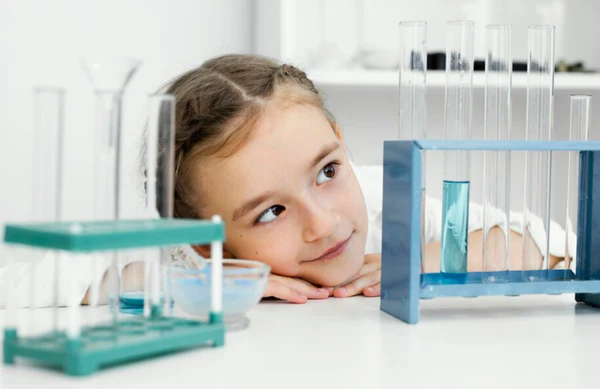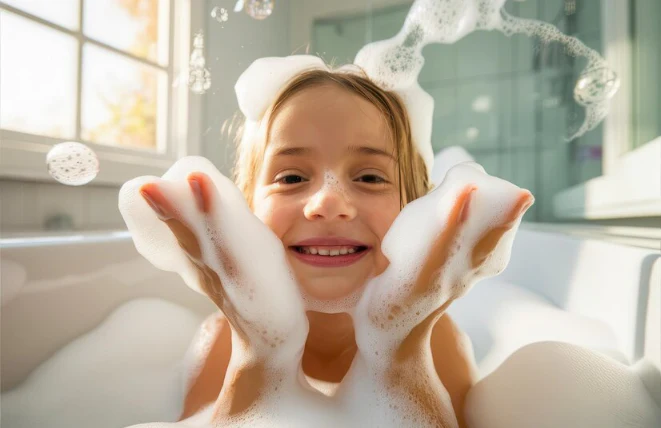A recent safety concern about hyaluronic acid for kids emerged after Kmart pulled a hyaluronic acid cleansing balm from its shelves. A teen who used the product ended up in the hospital with eye pain and blurred vision. This whole ordeal reflects a bigger trend. Young tweens and teens rush to malls to buy skincare products they’ve found on TikTok and Instagram.
The name hyaluronic acid might sound scary, but it’s actually a sugar-based molecule that exists naturally in our skin, eyes, joint fluid and connective tissue. Many parents still aren’t sure if hyaluronic acid products are right for their kids’ skin. Skincare experts say hyaluronic acid is generally safe for tween skin. The biggest problem comes from children using these products without knowing how the ingredients affect their skin. This piece looks at what parents should know about hyaluronic acid, its safety for different ages, and whether kids should include it in their skincare routine.

Table of Contents
- 1 What is hyaluronic acid and how does it work?
- 2 Is hyaluronic acid safe for kids’ skin?
- 3
- 4 When can hyaluronic acid cause problems?
- 5 What age is appropriate to start using it?
- 6 Safer skincare alternatives for kids and tweens
- 7 Summing all up
- 8 Here are some FAQs about if is hyaluronic acid safe for kids:
What is hyaluronic acid and how does it work?
Hyaluronic acid might sound scary because of the word “acid,” but this amazing molecule won’t harm you. This naturally occurring glycosaminoglycan (a type of sugar) helps maintain our body’s moisture balance and structural integrity.
Naturally found in the body
Our bodies produce hyaluronic acid as a vital component of connective tissues. The skin contains about 50% of the body’s total hyaluronic acid, which makes it essential for our largest organ. This versatile substance exists in joints, eyes, and organs like the kidneys and lungs.
Someone weighing around 70 kg (150 lb) has about 15 grams of hyaluronic acid in their body. The body renews one-third of this amount daily through natural processes. This constant renewal shows how important this substance is for normal body functions.
Role in hydration and skin health
Hyaluronic acid’s remarkable ability to retain moisture sets it apart. This powerful humectant binds up to 1,000 times its weight in water. It creates a gel-like substance that keeps skin hydrated and plump.
Your skin needs hyaluronic acid for several important functions:
- It maintains extracellular space and creates an open, hydrated structure for nutrients to pass through
- It regulates water balance and osmotic pressure in the dermis
- It gives skin cushioning properties by forming networks with other extracellular matrix proteins
- It supports tissue repair processes
The dermis contains more hyaluronic acid than the epidermis, and the papillary dermis has higher levels than the reticular dermis. This distribution helps your skin maintain moisture balance across different layers.
Why it’s used in skincare products
Your body’s natural hyaluronic acid production decreases with age. This reduction leads to skin dehydration, less elasticity, and wrinkle formation. Modern skincare products include this ingredient because it helps combat these aging signs.
Hyaluronic acid has become popular in skincare for good reasons:
It works as an excellent moisture-binding ingredient that helps skin retain water. The ingredient creates a protective film on your skin’s surface to prevent moisture loss. Your skin tolerates it well, and it rarely causes allergic reactions or irritation.
Skincare companies employ different sizes of hyaluronic acid molecules to achieve various benefits. Large molecules provide surface hydration, while smaller ones penetrate deeper into the epidermis. Many products combine different molecular weights to maximize benefits at various skin depths.
Most cosmetic formulations contain 0.2% to 1% hyaluronic acid. This amount provides good hydration without overwhelming the skin. You’ll find this versatile ingredient in serums, creams, and masks.
Is hyaluronic acid safe for kids’ skin?
Parents often feel nervous about using skincare ingredients on their children’s sensitive skin. The word “acid” raises immediate concerns. Many ask themselves: is hyaluronic acid safe for kids? Let’s learn what this ingredient really is and how it works with growing skin.
Understanding the term ‘acid’
The name “hyaluronic acid” might sound scary, but it’s not a true “acid” like others in skincare. Unlike acids that remove dead skin cells, hyaluronic acid (HA) does something completely different. It’s actually a type of sugar, which makes it gentle enough for sensitive skin. This key difference explains why hyaluronic acid doesn’t irritate skin like other acids in skincare products.
Our bodies naturally produce hyaluronic acid, including children’s bodies. Putting it on the skin just adds to what’s already there instead of introducing something foreign.
How it behaves on young skin
Young skin still builds its natural protective barrier. This makes parents wonder how skincare ingredients might affect this process. The good news is that hyaluronic acid works by attracting and holding water molecules. It helps keep skin moisturized without interfering with skin development.
Here’s what hyaluronic acid does for children’s skin:
- Protects the skin barrier against environmental pollutants
- Keeps skin’s natural defenses strong during weather changes
- Makes skin texture and elasticity better without causing irritation
- Adds moisture without blocking pores or overwhelming young skin
All the same, most research on active skincare ingredients focuses on older age groups. We don’t know everything about how these ingredients affect teen and preteen skin.
Dermatologist opinions on safety
Doctors say hyaluronic acid is safe to use on children’s skin. Dermatologists call it a non-irritating ingredient that works well with all skin types, even sensitive and developing skin.
Dr. Natalie Cunningham, a pediatric dermatologist, sees more 10-12 year olds interested in skincare. She says that while some active ingredients might not work well, gentle hydrating products can be good choices.
Dr. Tan adds: “Hyaluronic acid is a great moisturizing ingredient and promotes hydration. Hyaluronic acid is also suitable for acne-prone skin and sensitive skin”.
Of course, experts suggest these safety steps:
- Choose fragrance-free products with few ingredients to avoid irritation
- Start by applying once a day to check how skin reacts
- Do patch tests, especially on younger skin
- Talk to a pediatric dermatologist before trying new products
It’s worth mentioning that while hyaluronic acid itself is usually safe, the whole product formula matters substantially. Adult skincare products with hyaluronic acid might contain other ingredients that aren’t good for children’s skin. That’s why doctors usually suggest using products made specifically for children or those with minimal, gentle ingredients.
Finally, hyaluronic acid ranks among the safer skincare ingredients for children because it occurs naturally in the body and holds moisture without causing irritation. Each child’s skin reacts differently, so parents should watch carefully and get professional advice when adding any new skincare product to their child’s routine.
When can hyaluronic acid cause problems?
Hyaluronic acid is generally safe, but some situations might cause problems. These issues often relate to how products are made, how people use them, and how different skin types react. Parents should know what it all means before using hyaluronic acid products on their children.
Irritation from other ingredients in the product
Pure hyaluronic acid rarely causes bad reactions. Most skin problems blamed on hyaluronic acid actually come from other ingredients in the product.
Clinical data shows topical lotions and creams with hyaluronic acid don’t have known side effects since it’s already in your body. You might still have an allergic reaction to specific brands. This matters even more with adult products used on children because they often pack stronger active ingredients.
Common irritants among other ingredients with hyaluronic acid include:
- Preservatives that keep products stable
- Fragrance additives (these hit sensitive skin hard)
- Extra active ingredients like retinol or exfoliating acids
- Alcohol-based ingredients that dry out skin
Children’s sensitive skin faces bigger risks from these extra ingredients than from hyaluronic acid. You should look carefully at every ingredient before adding any product to your child’s skincare routine.
Eye sensitivity and contact risks
Your child’s eyes need extra care with hyaluronic acid products. Even though eyes naturally contain hyaluronic acid, products with this ingredient can sometimes bother them if they get in.
Eye exposure symptoms include conjunctivitis (pink eye), redness, and burning from drops. A teen’s recent hospitalization after using a hyaluronic acid cleansing balm shows why we need to be careful around eyes.
Hyaluronic acid has anti-inflammatory properties that usually reduce eye area redness and swelling. Products near eyes can still cause mild discomfort with stinging and redness that goes away quickly.
Watch your children after they use hyaluronic acid products near their eyes. Any irritation that sticks around longer than usual might need a doctor’s look.
Overuse or layering with other actives
Using too much hyaluronic acid can backfire. This happens most often through wrong application or too many products at once.
Some people say hyaluronic acid makes their skin feel drier. This happens because it pulls moisture from its surroundings. In dry places or with incorrect use, it might steal moisture from deeper skin instead of the air, which leads to more dehydration.
Studies show too much hyaluronic acid can cause redness and inflammation. Using it on dry skin instead of damp skin might pull moisture from deeper layers, leaving skin drier than before.
Piling on multiple hyaluronic acid products can overwhelm skin. One expert puts it simply: “A good serum once or twice daily gives you all you need”. Children’s sensitive skin makes this point even more important.
Mixing hyaluronic acid with other active ingredients might disrupt the skin barrier. The issue isn’t hyaluronic acid itself but overloading skincare routines, which can trigger sensitivity and irritation.
Your child’s skin will respond best to moderate use. Don’t use much of either hyaluronic acid product and follow proper application steps to avoid problems.
What age is appropriate to start using it?
Parents often wonder about the right age to start using skincare ingredients. Several factors determine if hyaluronic acid suits a child’s skin, such as individual needs and product formulation.
Is hyaluronic acid good for young skin?
Young skin responds well to hyaluronic acid’s gentle hydrating properties. The human body naturally produces hyaluronic acid, which makes it compatible with developing skin. This substance provides deep hydration without blocking pores or causing irritation, making it perfect for younger skin types.
Hyaluronic acid stands apart from other anti-aging ingredients. It maintains moisture levels rather than changing the skin’s structure. The skin’s natural balance stays intact without disrupting young skin’s regulatory systems. Many experts suggest people should start using hyaluronic acid products in their 20s. This ingredient acts as a humectant that locks moisture into the skin.
Can teens use hyaluronic acid safely?
Teenagers deal with hormone changes that affect their skin. They can safely add hyaluronic acid to their daily routine. This ingredient delivers moisture without feeling greasy or heavy – a vital feature for teens who might struggle with oily skin or acne. Proper hydration levels help balance oil production and reduce breakouts.
Dermatologists believe hyaluronic acid works safely and effectively on all skin types. This includes sensitive and acne-prone teenage skin. Its gentle nature and compatibility with growing skin make it an excellent choice for teens looking for hydration.
Is it okay for 11-year-olds or younger?
Tweens and younger children can usually use hyaluronic acid safely. One aesthetician explains, “Hyaluronic acid is usually safe for tween skin. It’s super gentle plus hydrating”. Children might need this ingredient when their skin feels dry, especially during cold weather.
Safety remains essential though. Many skincare products contain other active ingredients that young skin shouldn’t use. Preteens should stay away from products with retinol, vitamin C, alpha/beta hydroxy acids, and peptides. Products marketed as “anti-aging,” “wrinkle-reducing,” or “brightening” aren’t needed for young skin.
Professional guidance helps when adding any skincare ingredient to a child’s routine. Parents should look for fragrance-free, pediatric-approved formulas with few ingredients. Most children need only one application daily, and simplicity remains the life-blood of youth skincare.
Safer skincare alternatives for kids and tweens
The beauty industry targets younger audiences with aggressive marketing, which raises red flags as children just 6 years old now use products with strong, active ingredients. Dermatologists support age-appropriate alternatives to protect young, developing skin.
Simple skincare routines for young skin
Kids need uncomplicated skincare routines that work. Dermatologists agree on a simple three-step approach for tweens and teens: gentle cleansing, moisturizing, and sun protection. This minimal routine gives young skin everything it needs to stay healthy without overwhelming it.
Water-based cleansers work better than alcohol-based products that can harm developing skin. The best cleanser should not have fragrances or colorants to prevent sensitivity reactions. This becomes even more vital for children with eczema or naturally sensitive skin.
Recommended ingredients: niacinamide, ceramides
Young skin benefits from several gentle ingredients:
Ceramides make up about 50% of the skin’s barrier and help balance moisture. These natural lipids seal the gaps between skin cells. They lock in hydration and keep harmful substances away.
Niacinamide (vitamin B3) helps calm skin, builds a stronger barrier, and protects against environmental damage. Young users can safely add this gentle ingredient to their routine.
Hyaluronic acid adds moisture without feeling heavy or greasy, which makes it perfect for sensitive skin. One dermatologist says: “If your child asks for a serum, choose a hyaluronic acid product”.
What to avoid: retinol, AHAs, strong actives
Connecticut Children’s Physician-in-Chief strongly discourages children from using adult skincare products. Young skin doesn’t need anti-aging ingredients or harsh exfoliants that can harm its developing barrier.
Stay away from products with retinol, vitamin C, alpha/beta hydroxy acids, and peptides. Products labeled “anti-aging,” “wrinkle-reducing,” “brightening,” or “firming” often contain active ingredients that young skin shouldn’t use.
Sunscreen remains the life-blood of any skincare routine. Dermatologists call it the most important step to keep skin healthy long-term.
Summing all up
Hyaluronic acid ended up being one of the safer skincare ingredients kids can use, despite its scary-sounding name. Recent issues with hyaluronic acid products raised some concerns, but the molecule itself rarely causes problems. The real culprits are usually other ingredients in these formulations.
Your child’s body naturally produces hyaluronic acid, which makes it compatible with young skin. In spite of that, you should still be careful when adding any new skincare product to developing skin.
Kids’ skincare should be simple. Young skin doesn’t need complex routines or strong active ingredients. Basic cleansing, proper moisturizing, and regular sun protection are the foundations of healthy skin development.
Hyaluronic acid can be a good starting point to hydrate skin for tweens who show interest in skincare. But parents should get into the full ingredient lists and avoid products that contain retinol, strong acids, or anti-aging compounds that aren’t right for young users.
The rise of kids using complex skincare routines definitely needs attention. The molecule itself is safe, but beauty industry marketing often targets younger audiences with products they don’t need. Getting advice from parents and a pediatric dermatologist are a great way to get guidance before starting any skincare routine.
So what’s the bottom line? Hyaluronic acid safely hydrates kids’ skin when used properly in simple formulations. Just remember to keep things moderate – a child’s natural skin barrier works great on its own and needs minimal help to stay healthy during the growing years.
Here are some FAQs about if is hyaluronic acid safe for kids:
Can I use hyaluronic acid on kids?
Hyaluronic acid is generally considered safe for kids when used in appropriate formulations designed for children’s skin. Many pediatric dermatologists confirm that hyaluronic acid is it safe for kids in gentle, fragrance-free products at lower concentrations. However, parents should still patch test first and consult a doctor about is the ordinary hyaluronic acid safe for kids specifically, as adult formulations may be too potent.
At what age can I use hyaluronic acid?
Most experts suggest hyaluronic acid is safe for kids skin starting around age 10-12 for basic hydration needs. The question of is hyaluronic acid safe for kids depends more on the product formulation than age alone – teen-friendly versions exist. For younger children, is the ordinary hyaluronic acid safe for kids isn’t recommended without pediatric approval.
What skincare is ok for 10 year olds?
Basic skincare like gentle cleansers and fragrance-free moisturizers containing hyaluronic acid is safe for kids skin at this age. When considering is hyaluronic acid safe for kids of this age, opt for simple formulas without additional actives. Parents wondering is the ordinary hyaluronic acid safe for kids should know it’s better to choose products specifically formulated for pre-teen skin.
Who should not use hyaluronic acid?
While hyaluronic acid is it safe for kids generally, those with specific skin conditions or allergies should avoid it without medical approval. Individuals questioning is hyaluronic acid safe for kids with very sensitive skin or eczema should consult a dermatologist first. Even though is the ordinary hyaluronic acid safe for kids isn’t definitively established, most children without skin conditions can tolerate gentle HA products.
Is hyaluronic acid good for eczema?
Hyaluronic acid can benefit eczema-prone skin when properly formulated, and hyaluronic acid is it safe for kids with this condition in medical-grade products. Parents asking is hyaluronic acid safe for kids skin with eczema should look for ceramide-containing HA formulations. While is the ordinary hyaluronic acid safe for kids with eczema isn’t certain, pediatric dermatologists often recommend HA in therapeutic moisturizers.
Can a 12 year old use salicylic acid serum?
While hyaluronic acid is safe for kids skin at this age, salicylic acid requires more caution and should only be used under guidance. Unlike the question of is the ordinary hyaluronic acid safe for kids, salicylic acid products typically aren’t recommended for pre-teens. For acne concerns, parents confirming is hyaluronic acid safe for kids is a better starting point than stronger exfoliants.


